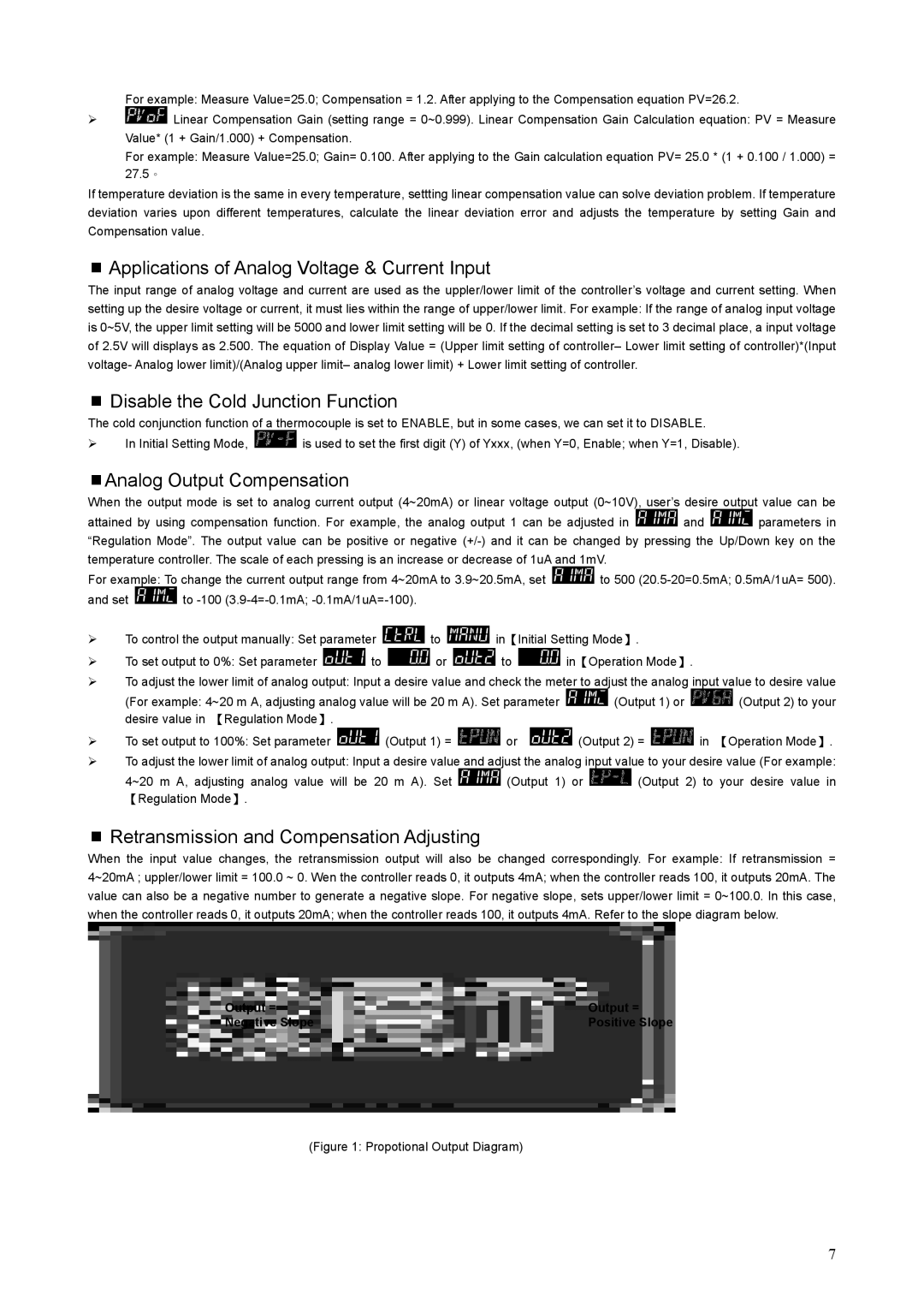
For example: Measure Value=25.0; Compensation = 1.2. After applying to the Compensation equation PV=26.2.
¾![]() Linear Compensation Gain (setting range = 0~0.999). Linear Compensation Gain Calculation equation: PV = Measure Value* (1 + Gain/1.000) + Compensation.
Linear Compensation Gain (setting range = 0~0.999). Linear Compensation Gain Calculation equation: PV = Measure Value* (1 + Gain/1.000) + Compensation.
For example: Measure Value=25.0; Gain= 0.100. After applying to the Gain calculation equation PV= 25.0 * (1 + 0.100 / 1.000) = 27.5。
If temperature deviation is the same in every temperature, settting linear compensation value can solve deviation problem. If temperature deviation varies upon different temperatures, calculate the linear deviation error and adjusts the temperature by setting Gain and Compensation value.
Applications of Analog Voltage & Current Input
The input range of analog voltage and current are used as the uppler/lower limit of the controller’s voltage and current setting. When setting up the desire voltage or current, it must lies within the range of upper/lower limit. For example: If the range of analog input voltage is 0~5V, the upper limit setting will be 5000 and lower limit setting will be 0. If the decimal setting is set to 3 decimal place, a input voltage of 2.5V will displays as 2.500. The equation of Display Value = (Upper limit setting of controller– Lower limit setting of controller)*(Input voltage- Analog lower limit)/(Analog upper limit– analog lower limit) + Lower limit setting of controller.
Disable the Cold Junction Function
The cold conjunction function of a thermocouple is set to ENABLE, but in some cases, we can set it to DISABLE.
¾In Initial Setting Mode, ![]() is used to set the first digit (Y) of Yxxx, (when Y=0, Enable; when Y=1, Disable).
is used to set the first digit (Y) of Yxxx, (when Y=0, Enable; when Y=1, Disable).
Analog Output Compensation
When the output mode is set to analog current output (4~20mA) or linear voltage output (0~10V), user’s desire output value can be
attained by using compensation function. For example, the analog output 1 can be adjusted in ![]() and
and ![]() parameters in “Regulation Mode”. The output value can be positive or negative
parameters in “Regulation Mode”. The output value can be positive or negative
For example: To change the current output range from 4~20mA to 3.9~20.5mA, set ![]() to 500
to 500
and set ![]() to
to
¾To control the output manually: Set parameter ![]() to
to ![]() in【Initial Setting Mode】.
in【Initial Setting Mode】.
¾To set output to 0%: Set parameter ![]() to
to ![]() or
or ![]() to
to ![]() in【Operation Mode】.
in【Operation Mode】.
¾To adjust the lower limit of analog output: Input a desire value and check the meter to adjust the analog input value to desire value
(For example: 4~20 m A, adjusting analog value will be 20 m A). Set parameter ![]() (Output 1) or
(Output 1) or ![]() (Output 2) to your desire value in 【Regulation Mode】.
(Output 2) to your desire value in 【Regulation Mode】.
¾ | To set output to 100%: Set parameter | (Output 1) = | or | (Output 2) = | in 【Operation Mode】. |
¾To adjust the lower limit of analog output: Input a desire value and adjust the analog input value to your desire value (For example:
4~20 m A, adjusting analog value will be 20 m A). Set ![]() (Output 1) or
(Output 1) or ![]() (Output 2) to your desire value in 【Regulation Mode】.
(Output 2) to your desire value in 【Regulation Mode】.
Retransmission and Compensation Adjusting
When the input value changes, the retransmission output will also be changed correspondingly. For example: If retransmission = 4~20mA ; uppler/lower limit = 100.0 ~ 0. Wen the controller reads 0, it outputs 4mA; when the controller reads 100, it outputs 20mA. The value can also be a negative number to generate a negative slope. For negative slope, sets upper/lower limit = 0~100.0. In this case, when the controller reads 0, it outputs 20mA; when the controller reads 100, it outputs 4mA. Refer to the slope diagram below.
Output = | Output = |
Negative Slope | Positive Slope |
(Figure 1: Propotional Output Diagram)
7
